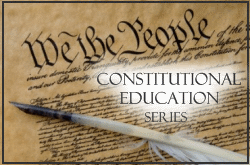 It’s important that we educate our children on the topics of politics, government, and the Constitution which governs our nation. This nine-part series attempts to remind us of some basic principles, lest they be forgotten by the next generation.
It’s important that we educate our children on the topics of politics, government, and the Constitution which governs our nation. This nine-part series attempts to remind us of some basic principles, lest they be forgotten by the next generation.In a recent news article, we see the state of California making clear its desire to self-impose tougher auto emissions standards than are called for by the federal government. The current president is mulling this over (the former president rejected it), while several other states are joining California in suing the federal government for not allowing the state to implement this law.
If you know anything about the Constitution and the original vision of the founders, you will see the incongruity of these stories with the ideals of our forefathers. The truth is that the original states were clearly separate from each other and largely independent of any federal restrictions. In fact, the founders’ vision was that power rested first with the individual, second with the state, and last at the federal level. Each state legislature wielded a great deal of power and independent decision-making ability. If this seems strange, consider this. Before 1913, United States senators were not elected. Instead, they were appointed by each state legislature (see the original Article 1, Section 3 of the Constitution), with the intent that they would vote along lines set by each legislature. U.S. senators were not given a very long leash to vote as they wished, because they ran the risk of being removed by the state. Their power derived from the state, which was itself made up of individuals who were fiercely loyal (and uniquely devoted) to their own state. This system of states’ rights, curiously, is called federalism. The attitude behind federalism is still in evidence in many states, many of which still take pride in claiming to be the “Show Me” state or were “First in Flight”. If you live in one of these states, you probably know who you are.
This changed in 1913 when the 17th Amendment was ratified by Connecticut, the last vote necessary to meet the Amendment criteria of thirty-six ratifying states. Specifically, the 17th Amendment allows for the direct election of U.S. senators every six years, rather than being appointed by the state legislatures. If the distinction between the two systems is lost on you, consider this: a U.S. senator now has no direct responsibility to act or vote along the lines directed by his people back in the state. Instead, he or she is now inundated with federal programs that must be managed across many states, and is constantly competing for federal money which may come back to his or her state, so that jobs are “created”, the people are somewhat satisfied, and the senator can gain re-election. This serves to vastly increase the role of the federal government in our everyday lives, while reducing the power and independence of the states. And this is evidenced in today’s headlines when the President is deciding whether or not to allow a state to enact more stringent guidelines than the federal government requires.
Just to state my point of view for a moment, I believe the states should be allowed to make all such decisions, on their own, without interference from the federal government. Montana should be free to set their highway speed limit wherever they like without the threat of the federal government refusing highway improvement money. In fact, they should take all of that federal tax money slated for highway improvements and give it back to the individual who paid it originally. If the state wants to enact a highway improvement, then let them do so through their own legislature, and the votes of the people. Why does the federal government take money from the taxpayer, only to distribute it back to the states? Such a system is inefficient and extremely subject to corruption.
As an example of the way things used to work before the 17th Amendment, consider the case of John Quincy Adams in 1809. His state legislature of Massachusetts made their mind known to him regarding a piece of trade embargo legislation, and instructed him to vote against the motion. He was not of this opinion, and so resigned his seat, rather than oppose his state lawmakers. Similarly, when President Andrew Jackson was censured in 1834 for posturing against the federal bank, seven U.S. senators resigned their post, rather than vote to remove the censure as their legislatures recommended. Can you imagine a senator doing this today? No, today our senators openly rally for campaign funds in other states and foreign countries, making them more open to corruption than ever.
James Madison had it right in Federalist #45 when he said, “each of the principal branches of the federal government will owe its existence more or less to the favor of the State governments, and must consequently feel a dependence”, and in Federalist #46 that the federal government will “be disinclined to invade the rights of the individual States, or the prerogatives of their governments.” Indeed, the Constitution itself was not ratified as a kind of “national” effort. It was studied, weighed and voted upon by individual states – each of which had differing overall opinions and discussions.
It’s important to understand how our government differs today from how the founders envisioned it. Perhaps it’s time to consider a repeal of an amendment or two. Frank Chodorov, author of The Income Tax: Root of All Evil, perhaps said it best when he stated, “The freedoms won by Americans in 1776 were lost in the revolution of 1913.”
Next article: Is it okay for the government to go into debt? Is it constitutional? Back to the main index article.











No comments:
Post a Comment